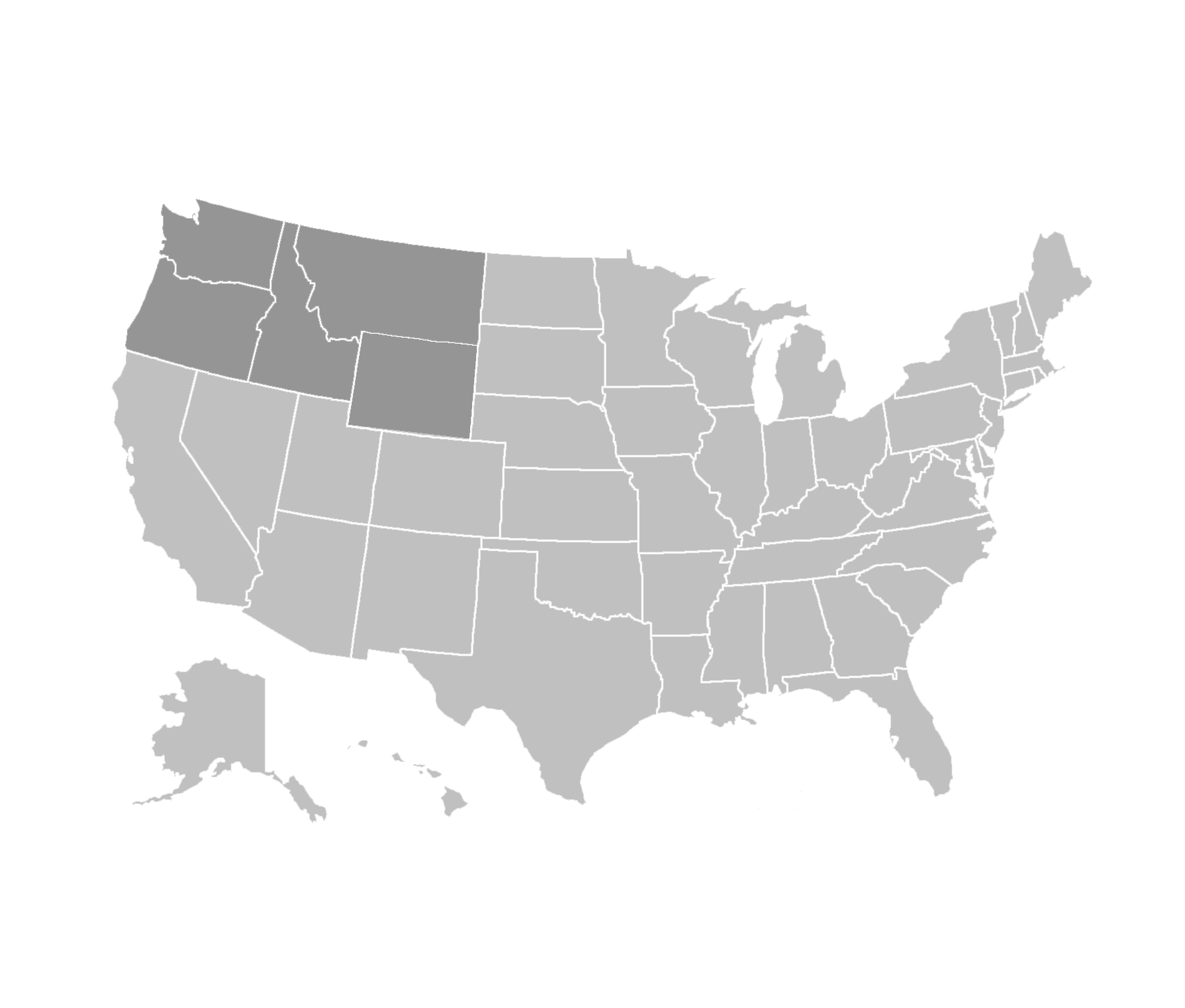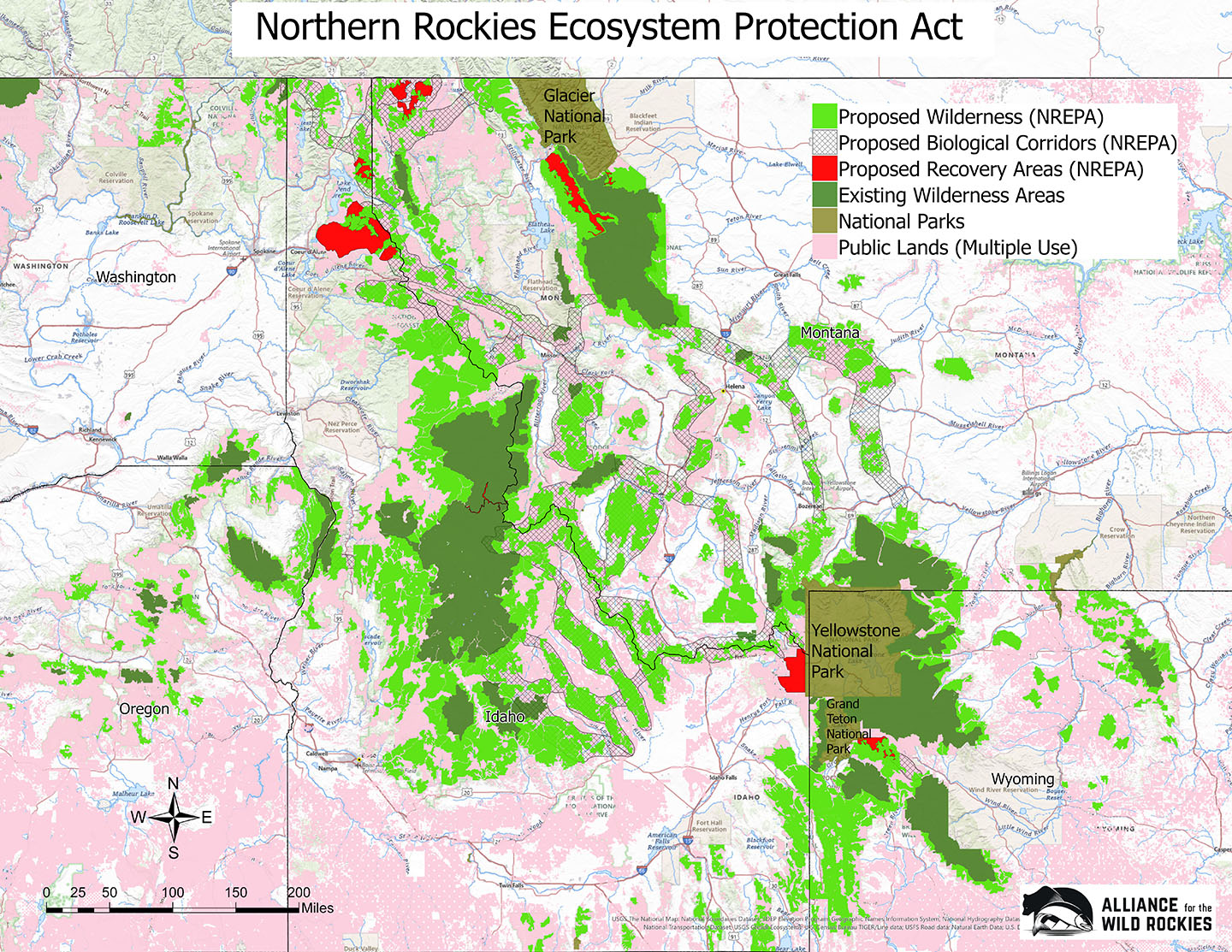Why is NREPA so important?
The Northern Rockies Ecosystem Protection Act was first introduced in 1993 to ensure the longterm survival of native species in the Northern Rockies. It was written by Alliance members including John Craighead, who was named by National Geographic as one of the top 100 scientists of the 20th century.
The Alliance exists to promote legislation that protects habitat and ecosystems in perpetuity, and to make sure there is something left to protect when the legislation is finally passed.
The Northern Rockies Ecosystem Protection Act (S. 1198)) in the Senate and (H.R. 2420) in the House is the only comprehensive solution for protecting our national heritage which lies in the mountains, meadows, and rivers of the Rocky Mountains of the great American West. These wildlands provide habitat for almost all the native species that were here when Europeans first arrived.
A Climate Solution
NREPA is a large-scale solution to the climate crisis. Trees pull carbon from the atmosphere and store it in the soil. Unlogged forests on public land in the Northern Rockies are natural, existing carbon storage machines that we don’t need to invent or build or pay for. Yet millions of acres of trees in the Northern Rockies are being removed for timber industry profit.
NREPA will designate millions of acres of unlogged forest as wilderness, prohibit logging, and maximize carbon sequestration in the protected areas. Will you join us in the fight to enact NREPA and slow climate change?
Protection
Though one may rarely stray from the hum of civilization, there is great satisfaction in knowing that wilderness still exists, largely untouched by the hand of man. Wilderness provides abundant clean water and air and gives us a place of refuge. It harbors thriving biodiversity and scientific discovery, and it is an integral part of our nation’s history.
Yet without protection from Congress or the President, this original American landscape is subject to deforestation, pollution, and development. Our public lands belong to all of us, and it is our duty to protect the immeasurable value of old-growth forests, snow-capped mountains, and freshwater rivers and lakes for many generations to come.
Protect Iconic Species
A powerful and enduring symbol of the American west, the nation’s last wild bison herd grazes on the open plains of this ancient landscape. Our country’s largest herd of bighorn sheep and elk also still roams the mountain slopes and forests, sustaining key predators like the grizzly bear and gray wolf. These iconic species have disappeared from other states due to habitat fragmentation, pollution, and direct conflict with humans.
LEARN MORE
Preserve Biodiversity
NREPA will establish corridors linking protected areas, helping to preserve genetic diversity and mitigating the conflict between wildlife and humans that occurs when we encroach on key habitats. These core ecosystems range from old-growth forests and glaciers to cactus desert and alpine tundra.
LEARN MORE
Combat Climate Change
Communities across the world are experiencing more extreme temperatures, the upset of both terrestrial and marine ecosystems, reduced snowpack, and a rise in the intensity and frequency of natural disasters. While places like the Wild Rockies still exist, we can stabilize the climate and preserve our planet for future generations.
LEARN MORE
Honor Our History
NREPA will protect North America’s largest wildland region south of Canada, that harbors almost all of the plant and animal species here at the time of the Lewis & Clark Expedition. 200 years ago, this famous journey took the explorers through the rugged terrain that lies within NREPA-protected lands. This is the original American landscape that reminds us why our ancestors fell in love with this country, and why it’s a legacy we must protect.
LEARN MORE
Strengthen Local Economies
The communities located near the perimeter of the protected lands will benefit from a thriving tourist industry, attracted by the unmatched opportunities for outdoor recreation. This sustainable industry creates jobs, provides additional tax revenue to local communities, and preserves a way of life.
LEARN MORE
How Will NREPA Work?
NREPA will protect the invaluable ecosystems of the Rocky Mountains bio-region by creating biological corridors that connect existing wilderness and roadless areas, This bioregion is currently threatened by continued fragmentation and destruction.
WHAT IS A BIOREGION?
A bioregion is a territory that can support healthy ecosystems and provide adequate habitat for keystone species, and may also consist of multiple ecosystems connected by wildlife corridors.
Properly designated and managed bioregions allow for human interaction with the landscape. Bioregions extend beyond political boundaries and therefore require cooperation to protect.
Within the Wild Rockies bioregion there are five main interconnecting ecosystems: Greater Yellowstone, Hells Canyon – Wallowa, Salmon Selway, Glacier Northern Continental Divide, and Cabinet – Yaak – Selkirk.
LEARN MORE about the lands of the bioregion.
What Lands Will NREPA protect?
NREPA-protected lands will stretch across almost 20 million acres of public domain in Idaho, Montana, Washington, Oregon, and Wyoming. Within this bioregion lie five diverse ecosystems, important both culturally and ecologically, that people come to experience from around the world.

NREPA Designations
Wild And Scenic Rivers
Wilderness
Biological Linkage Corridors
National Wildland Recovery System
Native American Religious and Treaty Rights
National Park Preserve Study Area
Here are four ways you can take action.
Let your voice be heard. Choose an action and do it now!
DONATE
Support AWR’s ongoing work to protect the Northern Rockies ecosystem so there is something left to protect when our NREPA bill finally becomes law.
CONTACT SENATE
Help get our NREPA bill sponsored in the Senate. Its easy to find your State Senators and send our pre-written message, or you can create your own.
CONTACT HOUSE
Help get NREPA sponsored in the House. Its easy to find your Representatives and send our pre-written message, or you can create your own.
Contact Us
If you have any questions or need support with using our website here’s how you can get in touch.
Main office: 406-410-3373
Email: wildrockies@gmail.com
USPS: Alliance for the Wild Rockies
P.O. Box 505 Helena, MT 59624
Executive Director: Mike Garrity
Join Our Facebook Community
